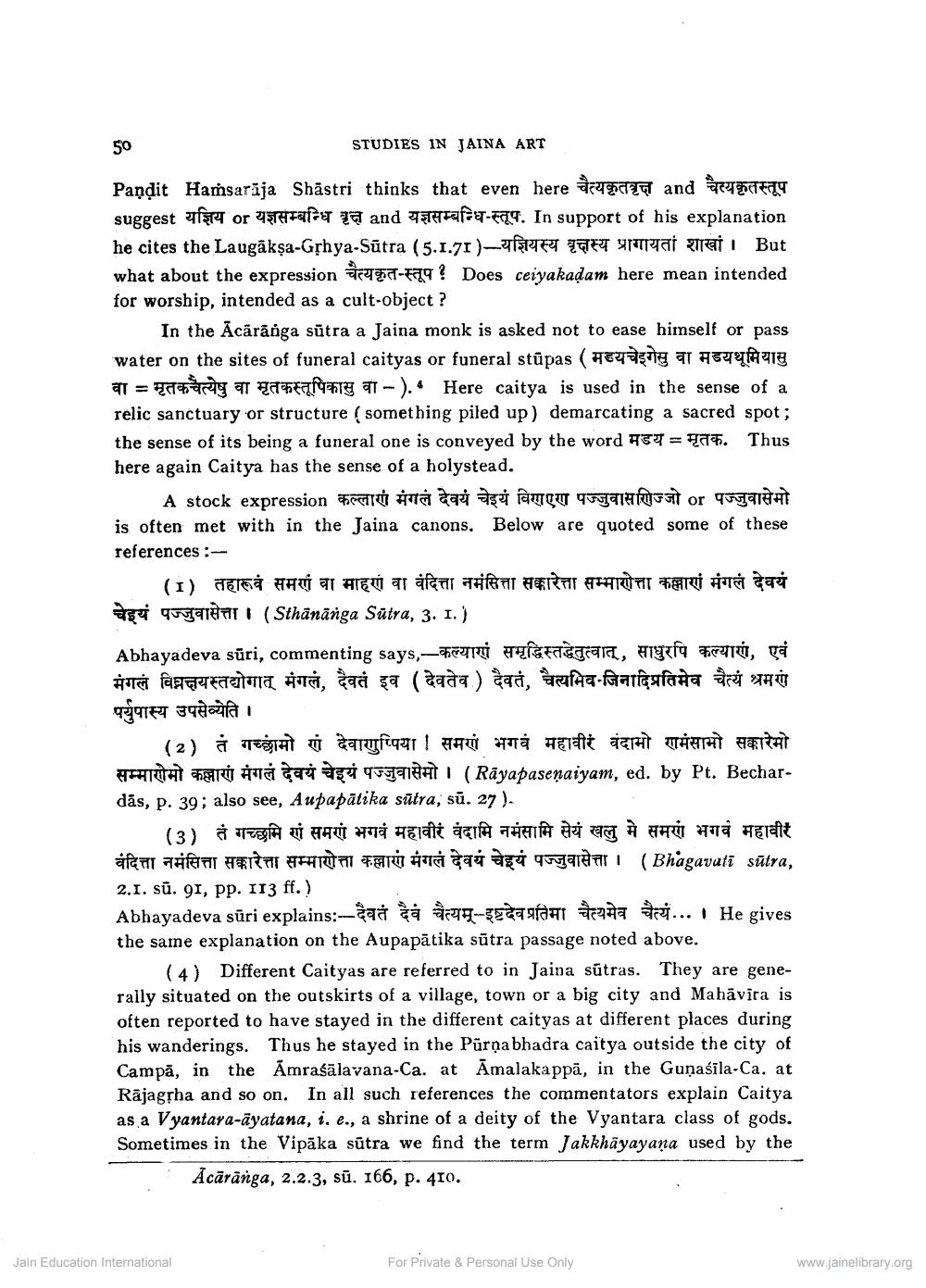________________
50
STUDIES IN JAINA ART
Pandit Hamsarija Shastri thinks that even here चैत्यकृतवृक्ष and चैत्यकृतस्तूप suggest यज्ञिय or यज्ञसम्बन्धि वृक्ष and यज्ञसम्बन्धि-स्तूप. In support of his explanation he cites the Laugaksa-Grhya-Sutra (5.1.71)-यज्ञियस्य वृक्षस्य प्रागायतां शाखां। But what about the expression चैत्यकृत-स्तूप ? Does ceiyakadam here mean intended for worship, intended as a cult-object ?
In the Ācārānga sūtra a Jaina monk is asked not to ease himself or pass water on the sites of funeral caityas or funeral stāpas (मडयचेइगेसु वा मडयथूमियासु वा = मृतकचत्येषु वा मृतकस्तूपिकासु वा -). Here caitya is used in the sense of a relic sanctuary or structure ( something piled up) demarcating a sacred spot; the sense of its being a funeral one is conveyed by the word मडय = मृतक. Thus here again Caitya has the sense of a holystead.
A stock expression कल्लाणं मंगल देवयं चेइयं विणएण पज्जुवासणिज्जो or पज्जुवासेमो is often met with in the Jaina canons. Below are quoted some of these references:
(1) तहारूवं समणं वा माहणं वा वंदित्ता नमंसित्ता सक्कारेत्ता सम्माणेत्ता कल्लाणं मंगलं देवयं चेइयं पज्जुवासेत्ता । (Sthānanga Sutra, 3. I.) Abhayadeva sāri, commenting says,-कल्याणं समृद्धिस्तद्धेतुत्वात् , साधुरपि कल्याणं, एवं मंगलं विघ्नक्षयस्तद्योगात् मंगलं, दैवतं इव ( देवतेव) देवतं, चैत्यभिव-जिनादिप्रतिमेव चैत्यं श्रमण पर्युपास्य उपसेव्येति।
(2) तं गच्छामो णं देवाणुप्पिया ! समणं भगवं महावीरं वंदामो मंसामो सकारेमो सम्माणेमो कल्लाणं मंगलं देवयं चेइयं पज्जुवासेमो। ( Rayapasenaiyam, ed. by Pt. Bechardās, p. 39; also see, Aupapātika sūtra, sū. 27).
(3) तं गच्छमि णं समणं भगवं महावीरं वदामि नमसामि सेयं खलु मे समण भगवं महावीर वंदित्ता नमंसित्ता सक्कारेत्ता सम्माणेत्ता कल्लाणं मंगलं देवयं चेइयं पज्जुवासेत्ता । ( Bhagavati sutra, 2.I. sā. 91, pp. II3 ff.) Abhayadeva suri explains:-दैवतं देवं चैत्यम्-इष्टदेवप्रतिमा चैत्यमेव चैत्यं... | He gives the same explanation on the Aupapātika sūtra passage noted above.
(4) Different Caityas are referred to in Jaina sútras. They are generally situated on the outskirts of a village, town or a big city and Mahāvira is often reported to have stayed in the different caityas at different places during his wanderings. Thus he stayed in the Pūrņabhadra caitya outside the city of Campā, in the Amraśālavana-Ca. at Amalakappa, in the Guņaśīla-Ca. at Rājagļha and so on. In all such references the commentators explain Caitya as a Vyantara-āyatana, i. e., a shrine of a deity of the Vyantara class of gods. Sometimes in the Vipāka sūtra we find the term Jakkhāyayana used by the
Acāranga, 2.2.3, sā. 166, p. 410.
Jain Education International
For Private & Personal Use Only
www.jainelibrary.org




